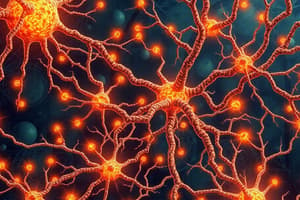Podcast
Questions and Answers
Which of the following is the chief inhibitory transmitter in the adult CNS?
Which of the following is the chief inhibitory transmitter in the adult CNS?
- GABA (correct)
- ENa
- Glutamate
- EK
What is the main body of a neuron called?
What is the main body of a neuron called?
- Axon terminal
- Dendrite
- Soma (correct)
- Synaptic
Which of the following is an electrotonic response that decays with an exponential time course?
Which of the following is an electrotonic response that decays with an exponential time course?
- Threshold potential
- Action potential
- IPSP
- EPSP (correct)
What type of summation occurs when EPSPs created by distant synapses overlap?
What type of summation occurs when EPSPs created by distant synapses overlap?
What is the neurotransmitter that opens cation channels and is the chief excitatory transmitter in the CNS?
What is the neurotransmitter that opens cation channels and is the chief excitatory transmitter in the CNS?
What is the term for the increased transmitter release produced by an action potential that follows closely upon a preceding action potential?
What is the term for the increased transmitter release produced by an action potential that follows closely upon a preceding action potential?
Which lobe of the cerebral cortex is responsible for auditory perception, semantics, and memory?
Which lobe of the cerebral cortex is responsible for auditory perception, semantics, and memory?
Which lobe of the cerebral cortex is the visual processing center?
Which lobe of the cerebral cortex is the visual processing center?
Which level of the central nervous system contains the medulla, pons, mesencephalon, hypothalamus, thalamus, cerebellum, and basal ganglia?
Which level of the central nervous system contains the medulla, pons, mesencephalon, hypothalamus, thalamus, cerebellum, and basal ganglia?
Which portion of the nervous system is responsible for tactile, visual, auditory, and olfactory sensations?
Which portion of the nervous system is responsible for tactile, visual, auditory, and olfactory sensations?
Which level of the central nervous system contains walking circuits, withdrawal circuits, and support against gravity circuits?
Which level of the central nervous system contains walking circuits, withdrawal circuits, and support against gravity circuits?
Which level of the central nervous system is essential for thought processes and functions in association with lower centers?
Which level of the central nervous system is essential for thought processes and functions in association with lower centers?
Which type of neurotransmitter is usually inhibitory in the central nervous system (CNS)?
Which type of neurotransmitter is usually inhibitory in the central nervous system (CNS)?
What is the main function of small molecule, rapidly acting transmitters in the nervous system?
What is the main function of small molecule, rapidly acting transmitters in the nervous system?
What is the role of neuropeptides in synaptic transmission?
What is the role of neuropeptides in synaptic transmission?
What is the mechanism by which mechanical deformation generates a receptor potential?
What is the mechanism by which mechanical deformation generates a receptor potential?
What is the term for the principle that each receptor responds to a limited range of stimuli and has a direct line to the brain?
What is the term for the principle that each receptor responds to a limited range of stimuli and has a direct line to the brain?
What environmental change increases neuronal excitability and can initiate petit mal seizures?
What environmental change increases neuronal excitability and can initiate petit mal seizures?
Which of the following is true about abnormal ion concentration in axon D?
Which of the following is true about abnormal ion concentration in axon D?
What happens when there is underactivity in synaptic sensitivity?
What happens when there is underactivity in synaptic sensitivity?
What happens when there is overactivity in synaptic sensitivity?
What happens when there is overactivity in synaptic sensitivity?
What is the characteristic of reverberatory circuits?
What is the characteristic of reverberatory circuits?
What type of information transmission does the ANS use to control vascular tone, gut tone, heart rate, etc.?
What type of information transmission does the ANS use to control vascular tone, gut tone, heart rate, etc.?
What is shown in Figure 47-16?
What is shown in Figure 47-16?
Which type of receptor responds only when a change in stimulus is taking place?
Which type of receptor responds only when a change in stimulus is taking place?
What is the mechanism of adaptation in mechanoreceptors like the Pacinian corpuscle?
What is the mechanism of adaptation in mechanoreceptors like the Pacinian corpuscle?
Which type of receptor continues to transmit impulses to the brain for long periods of time while the stimulus is present?
Which type of receptor continues to transmit impulses to the brain for long periods of time while the stimulus is present?
What is the importance of signal intensity in the interpretation of signals by the brain?
What is the importance of signal intensity in the interpretation of signals by the brain?
Which type of neuronal circuit comprises many different types of neuronal circuits and includes converging, diverging, reverberating, and inhibitory circuits?
Which type of neuronal circuit comprises many different types of neuronal circuits and includes converging, diverging, reverberating, and inhibitory circuits?
What is the mechanism that causes the prolonged output in a reverberatory circuit after a single input stimulus?
What is the mechanism that causes the prolonged output in a reverberatory circuit after a single input stimulus?
Flashcards are hidden until you start studying
Study Notes
Neuron Structure and Function
- Chief inhibitory transmitter in the adult CNS is GABA (Gamma-Aminobutyric Acid).
- Main body of a neuron is called the soma or cell body.
- Electrotonic response that decays with an exponential time course is known as a graded potential.
- EPSPs (Excitatory Postsynaptic Potentials) from distant synapses that overlap exhibit spatial summation.
Neurotransmitters
- Chief excitatory transmitter in the CNS that opens cation channels is glutamate.
- Increased transmitter release following closely upon a preceding action potential is termed facilitation.
- Small molecule, rapidly acting transmitters function primarily in fast synaptic transmission.
- Neuropeptides play a role in modulating synaptic transmission and can influence the strength of synaptic responses.
Cerebral Cortex and CNS Levels
- Temporal lobe is responsible for auditory perception, semantics, and memory.
- Occipital lobe is the primary visual processing center.
- Forebrain and hindbrain levels of the central nervous system include the medulla, pons, mesencephalon, hypothalamus, thalamus, cerebellum, and basal ganglia.
- The upper levels of the central nervous system are essential for higher thought processes and associations with lower centers.
Sensory Functions and Receptor Mechanisms
- The sensory system encompasses tactile, visual, auditory, and olfactory sensations.
- Mechanoreceptors convert mechanical deformation into receptor potentials through mechanotransduction.
- The principle of labeled line coding describes the specific pathway each receptor uses to communicate specific types of stimuli to the brain.
- Changes in environmental conditions, such as hypercapnia (increased CO2), can elevate neuronal excitability, potentially causing petit mal seizures.
Synaptic Sensitivity
- Underactivity in synaptic sensitivity may lead to diminished responses to stimuli.
- Overactivity in synaptic sensitivity can result in hyperexcitability or seizures.
- Reverberatory circuits are characterized by prolonged activity due to feedback loops that sustain output after a single input.
Information Transmission in the Nervous System
- The Autonomic Nervous System (ANS) utilizes hormonal and neurotransmitter signals to regulate vascular and gut tones and heart rate.
- Receptors that respond only during changing stimulus conditions are known as phasic receptors.
- Adaptation in mechanoreceptors, such as the Pacinian corpuscle, occurs via rapid adaptation to sustained stimuli.
- Tonic receptors consistently transmit signals to the brain as long as the stimulus is present, providing continuous feedback.
Signal Interpretation
- Signal intensity plays a crucial role in how the brain interprets sensory information, encoding the strength of stimuli.
- Neuronal circuits might include various types, such as converging, diverging, reverberating, and inhibitory networks.
- Prolonged output in reverberatory circuits after a single stimulus is caused by sustained positive feedback within the circuit.
Summary
- These concepts underline the complex interactions within the nervous system, highlighting synaptic processes, cortical functions, and sensory receptor mechanisms.
Studying That Suits You
Use AI to generate personalized quizzes and flashcards to suit your learning preferences.






